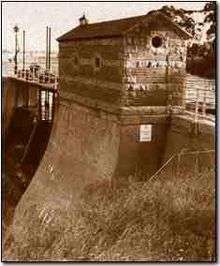Goulburn Weir
Goulburn Weir is a weir built between 1887 and early 1891 across the Goulburn River near Nagambie, Victoria, Australia.[1] It was the first major diversion structure built for irrigation development in Australia. The weir also forms Lake Nagambie where rowing regattas and waterskiing tournaments are held.

The Goulburn Weir allows water to be diverted by gravity via the Stuart Murray Canal and Cattanach Canal for off-river storage in the Waranga basin, for later use in irrigation.
The weir is 209 metres long by about 16 metres high. Its design was considered very advanced for its time, so much so that it featured on the back of half-sovereign and ten-shilling notes from 1913 to 1933. The structure also contained one of the first hydro-electric turbines in the southern hemisphere, used to supply power for lifting and lighting.
After more than 90 years of continuous service, many of the weir's components were in urgent need of replacement. Stabilisation works were done in 1983 and in 1987.
The weir raises the level of the Goulburn River so that water can be diverted, by gravity, along the main irrigation supply channels: Stuart Murray Canal, Cattanach Canal, East Goulburn Main Channel. The weir services nearby farming of crops including wheat, stock and domestic supplies.
Construction
Approval for the construction of the Goulburn Weir was granted on the 16th of December 1886, by the passing of The River Goulburn Weir Act 1886[2] . This act allowed the treasury of Victoria to issue up to £20,000 for the construction of the weir and related works. A further £75,000 was approved under The Water Supply Loans Act 1887.[3]
The construction of the weir began with the construction of six tunnels designed to pass the normal river flow. These would allow the construction of the masonry section of the weir to proceed with the river flows passing through the tunnels underneath. The tunnels were fitted with sluice gates that could be closed once the weir was completed allowing structure to raise the height of the river upstream.
The main body of the weir is constructed from concrete masonry, that is large concrete blocks that were bedded and jointed in cement mortar. It is backed with steps of granite blocks, each to the height of a course (2 feet).
The stone and sand for the concrete was sourced locally, the stone was quarried from a hill two miles (3.2 km) to the north and the sand was obtained from various pits within four miles (6.4 km) of the weir. The granite for the weir was sourced from Mount Black, 15 miles (24 km) to the south west.
The weir was completed, the tunnel sluices closed down and the river allowed to flow over the weir in the early part of December 1890. The water level upstream was slowly raised and storage reached its full supply level towards the end of July 1891.
The final cost of the weir works was £106,262.[4]
Notes
- "THE GOULBURN RIVER WEIR". The Leader (1603). Melbourne. 25 September 1886. p. 13. Retrieved 1 April 2017 – via National Library of Australia.
- "River Goulburn Weir Act 1886". AustLII. Retrieved 11 February 2013.
- "The Water Supply Loans Act 1887". AustLII. Retrieved 11 February 2013.
- Murray, Stuart (1883). The Goulburn Weir and Its Dependent System of Works. Treasury Gardens, Melbourne: Unknown.
References
- "Goulburn Weir 1887, Nagambie Victoria - Engineering Heritage Victoria". home.vicnet.net.au. Archived from the original on 17 September 2008. Retrieved 25 July 2008.
- "Goulburn Weir – Goulburn-Murray Water". www.g-mwater.com.au. Archived from the original on 20 July 2008. Retrieved 25 July 2008.
External links
![]()